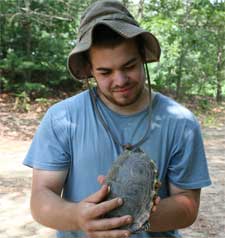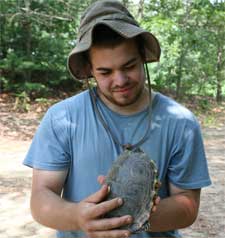 Research on tropical mammals, local turtles led to Fish & Wildlife job
Research on tropical mammals, local turtles led to Fish & Wildlife job
KINGSTON, R.I. – May 4, 2009 – Alex Patterson became interested in studying biology as a result of his enthusiasm for finding reptiles and amphibians around his Cranston neighborhood while growing up. As he prepares to graduate from the University of Rhode Island on May 17 as the University’s top wildlife biology student, he looks to his time spent studying mammals in Costa Rica as an important milestone.
“That trip was probably the best thing I ever did in college,” said Patterson. “There’s a big movement for shade grown coffee, where native trees are mixed in with coffee plants, and a lot of research has been done on its effects on bird populations, but not much about mammal populations. I learned a lot about field techniques for studying mammals, laying transects, different techniques for analyzing vegetation structure, and how to capture and handle mammals and take measurements.”
While in Costa Rica, he captured tropical mice, shrews, and opossums, and observed sloths, snakes and birds too numerous to count. “It was really an awesome experience,” he said.
Back home in Rhode Island, Patterson gained additional research experience studying diamondback terrapins, a rare turtle found in Barrington. He helped the Barrington Land Trust capture and mark the turtles in a long-term demographic study to better understand population changes.
“We’d get there in the morning and wait for the females to come out of the water to nest,” he said. “When it was done nesting, we would capture it, take measurements, if it had markings on it we would record those, and if not we’d give it a new mark. Some of the nests we transplanted to a predator excluder, a box in the sand that would incubate the eggs without allowing raccoons to come dig them up.”
A member of the URI Wildlife Society, Patterson continued his terrapin research as his senior thesis by modifying the predator excluder box so he could compare the nesting success rate of each turtle.
“I took measurements of females and their hatchlings to compare them to see what type of relationships there are,” he explained. “For instance, can you predict hatchling size from the size of the female? Does the size of the female affect the number of eggs she lays?”
Following graduation, Patterson will work for the U.S. Fish and Wildlife Service studying endangered piping plovers on the beaches of Rhode Island. He eventually wants to go to graduate school.
What kind of wildlife would he like to study next?
“I don’t really have a good answer for that yet,” he said. “I probably know the most about birds, but I’m also interested in reptiles, amphibians and mammals. I’ll just have to keep an eye out for what’s out there and take advantage of whatever opportunities come up.”


